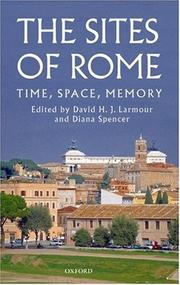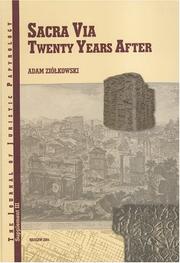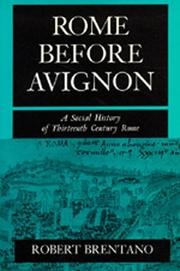| Listing 1 - 10 of 187 | << page >> |
Sort by
|

ISBN: 9780199217496 Year: 2007 Publisher: Oxford [etc.] Oxford University Press
Abstract | Keywords | Export | Availability | Bookmark
 Loading...
Loading...Choose an application
- Reference Manager
- EndNote
- RefWorks (Direct export to RefWorks)
Latin literature --- History and criticism --- Rome (Italy) --- Rome (Italy : Commune) --- Rome (Italy : Governatorato) --- Rūmah (Italy) --- Roma (Italy) --- Rom (Italy) --- Rím (Italy) --- Rzym (Italy) --- Comune di Roma (Italy) --- Rome --- History --- In literature. --- In motion pictures. --- Rome (Italy : Comune)

ISBN: 8391825027 Year: 2004 Publisher: Warsaw : Warsaw University. Institute of Archaeology,
Abstract | Keywords | Export | Availability | Bookmark
 Loading...
Loading...Choose an application
- Reference Manager
- EndNote
- RefWorks (Direct export to RefWorks)
Rome (Italy) --- Via Sacra (Rome, Italy) --- Sacra Via (Rome, Italy) --- Rome (Italy : Commune) --- Rome (Italy : Governatorato) --- Rūmah (Italy) --- Roma (Italy) --- Rom (Italy) --- Rím (Italy) --- Rzym (Italy) --- Comune di Roma (Italy) --- Rome --- Antiquities. --- Historical geography. --- Rome (Italy : Comune)
Book

ISBN: 9789462986152 9789048537372 9789048537389 9462986150 Year: 2018 Publisher: Amsterdam AUP
Abstract | Keywords | Export | Availability | Bookmark
 Loading...
Loading...Choose an application
- Reference Manager
- EndNote
- RefWorks (Direct export to RefWorks)
Al sinds de Oudheid staat Rome bekend als de Eeuwige Stad. En terecht, want de stad herbergt talloze vroeg-Romeinse overblijfselen. Maar naast het fysieke Rome kennen we ook het Rome zoals dat is overgeleverd in de antieke literatuur. Talloze gebouwen die allang verloren zijn gegaan leven voort in deze teksten. In De vereeuwigde stad staan beschrijvingen van twintig van dergelijke Romeinse locaties centraal. Met auteurs als Ovidius, Cicero en Vergilius als reisleider wordt een beeld geschetst van wat er ooit was. Het bijzondere van deze reisgids is dat hij een indruk geeft van het effect dat de monumenten hadden op de oude Romeinen. De lezer wordt meegenomen op een literaire wandeling door Rome en kan zich in heden en verleden oriënteren met behulp van een aantal plattegronden. Oude prenten en schetsen wakkeren de verbeelding verder aan. Zo spreekt het Rome van tweeduizend jaar geleden, vereeuwigd in literatuur, weer directer tot ons dan slechts door de fysieke resten. Met deze reisgids in de rugzak kun je terug stappen in de tijd en als een Romein naar de antieke monumenten kijken.
Classical literature --- Regional documentation --- Roman history --- Rome --- Rome (Italy) --- Rome (Italy : Comune) --- Rome (Italy : Governatorato) --- Rūmah (Italy) --- Roma (Italy) --- Rom (Italy) --- Rím (Italy) --- Rzym (Italy) --- Comune di Roma (Italy) --- In literature

ISBN: 0520069528 0465071252 0585114544 Year: 1990 Publisher: Berkeley : University of California Press,
Abstract | Keywords | Export | Availability | Bookmark
 Loading...
Loading...Choose an application
- Reference Manager
- EndNote
- RefWorks (Direct export to RefWorks)
Rome (Italy) --- Rome (Italy : Commune) --- Rome (Italy : Governatorato) --- Rūmah (Italy) --- Roma (Italy) --- Rom (Italy) --- Rím (Italy) --- Rzym (Italy) --- Comune di Roma (Italy) --- Rome --- History --- Social conditions. --- Rome (Italy : Comune) --- Regions & Countries - Europe --- History & Archaeology --- Italy
Book
ISBN: 1316997820 1108686680 1108481280 1108653928 Year: 2019 Publisher: Cambridge : Cambridge University Press,
Abstract | Keywords | Export | Availability | Bookmark
 Loading...
Loading...Choose an application
- Reference Manager
- EndNote
- RefWorks (Direct export to RefWorks)
The Roman Empire traditionally presented itself as the centre of the world, a view sustained by ancient education and conveyed in imperial literature. Historiography in particular tended to be written from an empire-centred perspective. In Late Antiquity, however, that attitude was challenged by the fragmentation of the empire. This book explores how a post-imperial representation of space emerges in the historiography of that period. Minds adapted slowly, long ignoring Constantinople as the new capital and still finding counter-worlds at the edges of the world. Even in Christian literature, often thought of as introducing a new conception of space, the empire continued to influence geographies. Political changes and theological ideas, however, helped to imagine a transferral of empire away from Rome and to substitute ecclesiastical for imperial space. By the end of Late Antiquity, Rome was just one of many centres of the world.
Church history --- Space (Philosophy) --- Historiography. --- History. --- Rome --- Rome (Italy) --- Roman provinces --- History --- Rome (Italy : Commune) --- Rome (Italy : Governatorato) --- Rūmah (Italy) --- Roma (Italy) --- Rom (Italy) --- Rím (Italy) --- Rzym (Italy) --- Comune di Roma (Italy) --- Rome (Italy : Comune)

ISBN: 1281149632 9786611149635 019152719X 9780191527197 0199217491 9780199217496 9781281149633 6611149635 1383035571 Year: 2007 Publisher: Oxford New York Oxford University Press
Abstract | Keywords | Export | Availability | Bookmark
 Loading...
Loading...Choose an application
- Reference Manager
- EndNote
- RefWorks (Direct export to RefWorks)
This is a collection of essays exploring how the visible components of Rome - the hills, the Tiber, the temples, the Forums, the Colosseum, the statues and monuments - operate as, or become, the sites/sights of Rome. The variety of theoretical approaches stimulates fresh thought about Rome's primacy in Western culture.
Latin literature --- History and criticism. --- Rome (Italy) --- Rome (Italy : Commune) --- Rome (Italy : Governatorato) --- Rūmah (Italy) --- Roma (Italy) --- Rom (Italy) --- Rím (Italy) --- Rzym (Italy) --- Comune di Roma (Italy) --- Rome --- In literature. --- History --- In motion pictures. --- Rome (Italy : Comune)
Book
ISBN: 1316219704 1108083242 Year: 2015 Publisher: Cambridge : Cambridge University Press,
Abstract | Keywords | Export | Availability | Bookmark
 Loading...
Loading...Choose an application
- Reference Manager
- EndNote
- RefWorks (Direct export to RefWorks)
This useful topographical dictionary was compiled by Samuel Ball Platner (1863-1921) of Western Reserve University in collaboration with Thomas Ashby (1874-1931), the third director of the British School of Archaeology at Rome. Sadly, Platner died before the work was completed, and Ashby eventually published it in 1929. The bulk of the work is an alphabetical list of the buildings, streets and geographical features in ancient Rome mentioned by ancient authors and/or discovered by more recent exploration and excavation of the ruins, with details about literary and historical references, and about the original and any surviving structure. There is also a chronological index to those monuments and other buildings that are dateable, and a large map (downloadable from the web at www.cambridge.org/9781108083249). With listings from 'Acca Larentia' to 'Zater(...nses)', the work is an invaluable tool in the exploration of Rome, whether by the scholar, student, or visitor.
Rome (Italy) --- Antiquities --- Description and travel --- Rome (Italy : Commune) --- Rome (Italy : Governatorato) --- Rūmah (Italy) --- Roma (Italy) --- Rom (Italy) --- Rím (Italy) --- Rzym (Italy) --- Comune di Roma (Italy) --- Rome --- Rome (Italy : Comune)

ISBN: 0521782481 Year: 2002 Publisher: Cambridge Cambridge University Press
Abstract | Keywords | Export | Availability | Bookmark
 Loading...
Loading...Choose an application
- Reference Manager
- EndNote
- RefWorks (Direct export to RefWorks)
History --- art history --- art theory --- Art --- Bellori, Giovanni Pietro --- anno 1600-1699 --- Italy --- History as a science --- Rome --- Art critics --- Critics --- Historiography --- Bellori, Giovanni Pietro, --- Bellori, Giovan Pietro, --- Bellori, Gio. Pietro --- Rome (Italy) --- Rome (Italy : Commune) --- Rome (Italy : Governatorato) --- Rūmah (Italy) --- Roma (Italy) --- Rom (Italy) --- Rím (Italy) --- Rzym (Italy) --- Comune di Roma (Italy) --- Civilization --- Biography --- 17th century --- Rome (Italy : Comune)
Periodical
ISSN: 2240967X Publisher: Roma : "L'Erma" di Bretschneider
Abstract | Keywords | Export | Availability | Bookmark
 Loading...
Loading...Choose an application
- Reference Manager
- EndNote
- RefWorks (Direct export to RefWorks)
Archeologie. --- Rome (Italy) --- Antiquities --- Rome (Italy : Commune) --- Rome (Italy : Governatorato) --- Rūmah (Italy) --- Roma (Italy) --- Rom (Italy) --- Rím (Italy) --- Rzym (Italy) --- Comune di Roma (Italy) --- Rome --- Antiquities. --- Italy --- Archaeological specimens --- Artefacts (Antiquities) --- Artifacts (Antiquities) --- Specimens, Archaeological --- Material culture --- Archaeology --- Rome (Empire) --- Rome (Italy : Comune)
Book
ISBN: 3769615646 9783769615647 Year: 1992 Volume: 1992/2 Publisher: München : Bayerische Akademie der Wissenschaften,
Abstract | Keywords | Export | Availability | Bookmark
 Loading...
Loading...Choose an application
- Reference Manager
- EndNote
- RefWorks (Direct export to RefWorks)
Historians --- Biography --- -Historiographers --- Scholars --- Gregorovius, Ferdinand --- Rome (Italy) --- -Historiography --- -Biography --- Gregorovius, Ferdinando --- Gregorovius, Ferdinand, --- Gregorovios, Pherdinandos, --- Gregorovius, Ferdinand Adolf, --- Gregoroviou, Pherdinandou, --- Gregorovius, F. --- Gregorovius, Ferdinando, --- Gregorovius, Ferdynand, --- Rome (Italy : Commune) --- Rome (Italy : Governatorato) --- Rūmah (Italy) --- Roma (Italy) --- Rom (Italy) --- Rím (Italy) --- Rzym (Italy) --- Comune di Roma (Italy) --- Rome --- Historiography. --- Historiographie --- Rome (Italy : Comune) --- Historians - Germany - Biography
| Listing 1 - 10 of 187 | << page >> |
Sort by
|

 Search
Search Feedback
Feedback About UniCat
About UniCat  Help
Help News
News